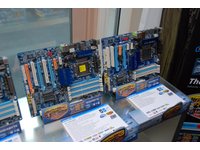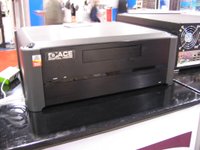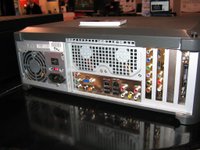CES '09: Morsels From Our Meetings
Gigabyte's Affordable X58 And Ace's Maui
Gigabyte Goes Crazy For X58
So many of the X58 boards we’ve looked at already (and indeed, will be looking at in our upcoming X58 motherboard roundup) represent the target market for Core i7 right now—enthusiasts with money to spend on high-performance hardware.
However, the company had its entire lineup of X58-based boards on display at CES. And while it does cover the power user base, we were most impressed with the EX58-UD3R, which is now selling for less than $200. Yes, the board only includes four DDR3 memory slots and does sacrifice SLI licensing in order to keep costs down. But it still boasts a pair of 16-lane PCI Express (PCIe) 2.0 slots with CrossFireX support and the X58 platform’s other salient features. That’s quite a coup for Gigabyte, which is inching the X58 platform closer to the $150 range of many 790GX-based boards and eroding some of the price advantage Phenom II holds over Core i7.


There are several competing models between the UD3R and Gigabyte’s next highest X58 offering, the EX58-UD4P (at $260). However, now you have the six memory slots and SLI support back in play. Much of the cost difference between the UD4P and the $300 EX58-UD5 is attributable to the commodity cost of the extra onboard cooling, according to company representatives, making the UD4P the best no-compromise value from Gigabyte.
Ace Computers Shows Up With A Little Bit Of Maui
Late last year, AMD sent us a complete HTPC based on its Maui platform—think Spider, but for your living room. We haven’t had a chance to spend enough quality time in front of Maui to get a solid evaluation of the technology written up yet, but we wanted to make it a point to stop by Ace Computers this year to see what actual system builders are doing with the platform.


The closest match to the system AMD sent us was Ace’s LMS 400, based on the same MSI-7411 motherboard and armed with Intersil’s D2Audio DAE-3 audio engine with a 5x100 W amplifier card. The LMS 400 is so well-equipped, in fact, that it could very well replace several components in your entertainment rack. Blu-ray playback, 1080p output through onboard Radeon graphics, CableCard/HD tuner support, and the five-channel amp cover the bases.
Get Tom's Hardware's best news and in-depth reviews, straight to your inbox.
We snapped shots of another model that we weren’t able to find in Ace’s press kit, which is also based on the Maui platform.
Current page: Gigabyte's Affordable X58 And Ace's Maui
Prev Page Samsung's SSDs And LCDs Next Page OCZ Talks About The Future